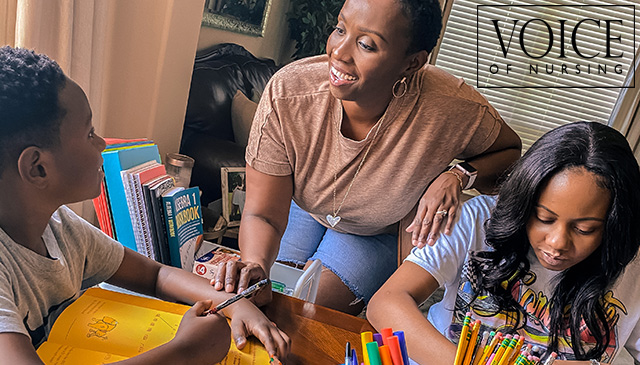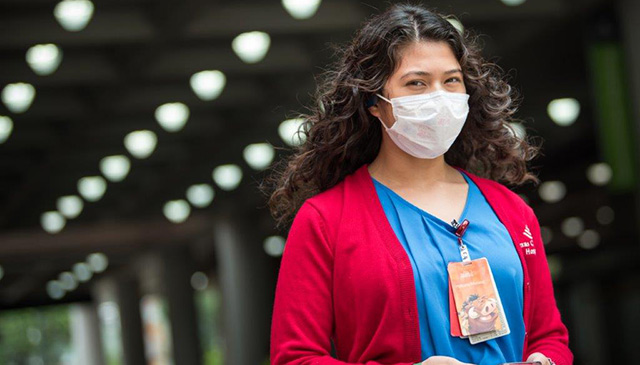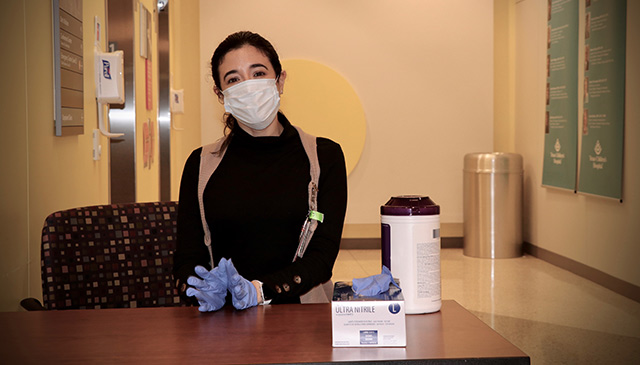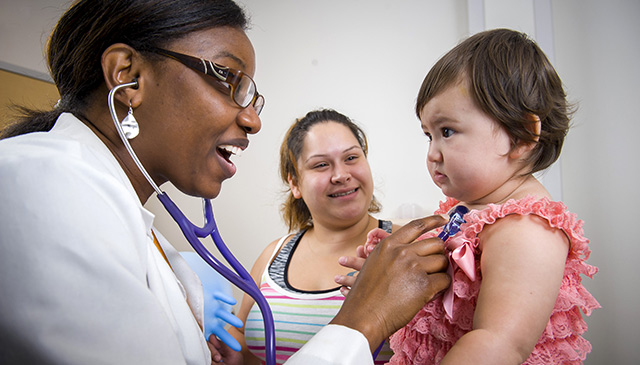
Texas Children’s medical staff is sharing a collection of wellness tips covering a variety of topics in hopes it will help those working so hard for our patients and families during the pandemic. Read more

Texas Children’s medical staff is sharing a collection of wellness tips covering a variety of topics in hopes it will help those working so hard for our patients and families during the pandemic. Read more

As a new school year begins, Denise Tanner-Brown shares helpful tips to prepare parents and children for virtual learning at home during COVID-19. Read more

As children across Texas head back to school this month and next, Texas Children’s is preparing for a potential spike in COVID-19 cases. Although it is unclear what will happen when kids return to class, there is a chance that more people will contract COVID-19 due to increased exposure to the virus.
Denise Tanner-Brown, assistant vice president of Community and Ambulatory Nursing, said she is cautiously optimistic considering many schools are starting back virtually, but that no one knows what the next step might be and how that will affect the situation.
“We are standing ready for a second wave of cases and are not letting down our guard,” Tanner-Brown said. “As patient volumes decrease, we have a deactivation strategy where we can temporarily close down units. But, we also have an activation strategy in place where we can turn it back on really quickly should the situation change.”
Critical Care Director of Nursing Shannon Zerber said one of the things Texas Children’s has done well throughout the pandemic that’s reduced the stress of potential surges is adequate planning for space and staff.
A team of experts from across the organization has a tri-campus multitier plan that lays out multiple levels of response. The plan starts with sending patients to the Special Isolation Unit at Texas Children’s Hospital West Campus. Additional beds dedicated to COVID-19 patients are designated at Texas Children’s Hospital in the Medical Center Main Campus, including 13 acute care beds, and six additional ICU beds.
“As our COVID-19 volumes change at Texas Children’s, in Houston and the region, we adapt and flex to demand,” Zerber said. “There is a patient placement group that meets routinely to look at the latest data, so we are ahead of things, not behind. We are anticipating what will happen next.” As a result, Zerber said “everyone is prepared for a spike when school goes back, especially face to face. We all hope it won’t happen but we are ready if it does.”
Dr. Amy Arrington, medical director of the SIU, said the biggest surge Texas Children’s has seen so far was at the end of June and the beginning of July. During that time, all 18 beds in the dedicated biocontainment unit were full and patients were also being cared for at the Medical Center campus.
Since then, the number of COVID-19 patients has dropped, but there has been an increase in the number of patients with multi-system inflammatory syndrome (MIS-C), a delayed inflammatory response to COVID-19 that typically presents four to six weeks after exposure. The syndrome is typically seen in children and teenagers and has varying effects on vital organs, including the heart. Arrington said although the condition is rare, clinicians across the nation are seeing an uptick in cases and that this trend could continue as more children head back to school and are potentially exposed to and contract COVID-19.
Caring for patients with MIS-C takes a tremendous amount of resources and expertise as many patients require stays in the intensive care unit, some of whom need specialized treatment such as extracorporeal membrane oxygenation (ECMO), a treatment that uses a pump to circulate blood through an artificial lung back into the bloodstream.
Texas Children’s has the resources and the expertise to care for these patients. We have intensive care specialists, cardiologists, surgeons, and specialists in rheumatology, infectious diseases and immunology investigating and treating the children as aggressively as needed to ensure they have the best possible outcome.
Chief of Critical Care Dr. Lara Shekerdemian, who has been directly involved in the organization of the intensive care of the 30 plus MIS-C cases at Texas Children’s throughout the pandemic, said Texas Children’s has the capacity to handle a surge of these patients even if it means using areas that aren’t currently being used. Although she said it is unlikely we will see an exponential growth in the number of cases of MIS-C, Shekerdemian emphasized that the capacity is there to care for all those who need the specialized care Texas Children’s can provide.
Arrington agreed and said “So far, space and staffing have never been an issue due to adequate planning and dedicated staff willing to show up for countless extra shifts, work as a unified team and generally go above and beyond. But, we must remain vigilant in our prevention and safety measures.”
Dr. Judith Campbell, medical director of Infection Control and Prevention, added that clinicians at Texas Children’s and other medical institutions from across the world are in a much better position to care for COVID-19 and MIS-C patients than they were in March when the pandemic began.
“We have good evidence now about how to care for patients safely,” Campbell said. “We also have a better supply of personal protective equipment, which makes clinicians and staff feel safer when they are caring for a positive patient.”
Staying on top of the latest research, looking at where we can do better and remaining steadfast in our dedication to our safety measures and protocols, however, are key to our continued success, Campbell said, adding that there is no room to lessen our determination in this pandemic.
Texas Children’s remains committed to providing the safest environment for our patients, families and employees. Since the beginning of the pandemic, we have done an excellent job at keeping people safe while continuing to be there for our patients and deliver top notch care.
Three safety measures that have been implemented across our system and that work very well revolve around screening, social distancing and wearing the proper personal protective equipment. We are constantly adapting and improving these efforts as the situation progresses and changes, but believe we have established a good foundational practice that will be part of our organization for some time to come.
As a reminder, everyone who walks into one of our facilities is stopped and screened for symptoms of COVID-19. Patients, family members and employees alike must fill out a questionnaire about any current symptoms they might have and any recent trips they might have taken. The screening process also includes a temperature check. Months ago, we invested in thermal imaging cameras at our three hospitals to expedite the process and to make it safer for our employees who are administering the screenings.
When on our campus or in any of our facilities, we ask patients, family members and even our own employees to please keep a safe distance of approximately 6 feet from others whenever and wherever possible, including waiting in line and riding in our elevators. We have placed signs and stickers across the system to help keep social distancing top of mind.
Wearing a mask is a must if you want to visit one of our facilities. Patients, family members, visitors and employees are issued a hospital-grade mask after being screened at one of our screening stations. Providers working in certain areas of our system wear additional PPE such as an N-95 mask, a procedure mask, goggles and/or an isolation gown depending on their risk level.
We also have instituted visitor restrictions, video and drive-through visits, precheck-in and online appointment and payment via MyChart, and curbside pharmacy pickup to mitigate any potential exposure to COVID-19 and to alleviate people’s worries about coming to one of our facilities for care.
We have robust testing capabilities and the nation’s largest pediatric primary care network in the nation standing on the front lines of this pandemic triaging patients who might have the virus and helping care for those who do. Texas Children’s Pediatrics is also helping administer COVID-19 tests at our testing sites across the organization and they are continuing to administer much-needed wellness visits and routine vaccines, including the flu vaccine, which will be more than ever for people to receive.
“We have been thoughtful and careful in our planning so that we can turn on a dime if we need to,” said Texas Children’s Pediatrics President Kay Tittle. “Throughout this pandemic, we have figured out how to be more flexible to meet the needs of our families. This will continue to be key in order for us to stay the course and to face whatever comes next.”
Shekerdemian said testing will be extremely important when school opens in order to slow the spread of the virus. It is imperative, she said, that people are honest with themselves and others when they don’t feel well.
“Don’t brush things aside,” Shekerdemian said. “If you (or your family member) don’t feel well, then call your physician and if necessary, isolate yourself and get a test.”
Campbell agreed and said the fall will definitely present an interesting chapter in the story of COVID-19 as it overlays other virial infections that occur commonly in the fall and winter months.

Jennifer Abernathy shares how fulfilling a new hobby has helped her stay mentally grounded during COVID-19, and hopes her experience inspires other nurses to pursue fun activities to help them relax and recharge during this pandemic. Read more

In keeping with Texas Children’s pledge to support you in every aspect of your well-being, we’ve compiled resources to help keep your families healthy and strong. This handy guide covers various topics such as parenting resources, tips for physical activity, nutrition, stress management and much more. Read More

As work life began to change for many Texas Children’s employees, the introduction of the Labor Pool system has brought new opportunities. Employees who normally serve in administrative or office roles have been able to interface with patients and families in a new way.
Kathleen Wood, director of Business Services with Texas Children’s Physicians Services Organization, manages the Labor Pool operation at the Medical Center. She said that although providing new insights and perspectives to employees was not an initial primary goal of the program, it has been a joy to see this emerge as an outcome.
“I understand this benefit in a very personal way,” Wood said. “In the past, while working in Revenue Cycle, I also volunteered in patient transportation at West Campus Radiology. That time spent on the front lines reaffirms the purpose of the organization and the importance of what we all do.”
Barbara Shreffler, manager of Research in the Office of Philanthropy, has spent the last two months managing several screening locations across main campus including Feigin, West Tower, Abercrombie and MPERT.
Shreffler said the work is challenging, but equally rewarding. “How else would I get to know emergency room nurses, pharmacists and other clinical professionals?,” said Shreffler, whose full-time job doesn’t require her to go into a patient care area. “I can honestly say that I have made new friends and I really do think that this experience will make me a better member of the philanthropy team.”
She went on to say that she has a reinvigorated enthusiasm to do more for Texas Children’s. “This Labor Pool role has made me more knowledgeable and more passionate about my work.”
Shreffler is not alone in how she feels. Elizabeth More, who works as a physician liaison in the Fetal Center, joined Labor Pool in April and became a team lead for screening at Legacy Tower and the Pavilion for Women.
“In my current role, I establish relationships with referring providers and their staff. My hope is that by building these trusting relationships with potential and/or referring providers, they will refer their patients to us for evaluations and interventions,” More said. “However, it is very rare that I have any interactions with the patients that they refer to us. My Labor Pool assignment has opened my eyes to see things from our families’ perspective.”
Some employees have an opportunity to work in a variety of roles. Diane Ramirez, a medical interpreter, has worked several positions for labor pool with the most recent one being as an elevator ambassador.
“This position, in particular, gave me a better sense of understanding on how the patients and their families feel nowadays when they visit our facilities,” Ramirez said. “Labor pool assignments gave me the opportunity to empathize with our visitors and take pride in our role in the community during these difficult times.
Some employees are not only gaining new insights but also new career skills. Kelley Hernandez, a senior coordinator in the Office of Philanthropy, began as a team lead for the screening areas in March and became a Labor Pool coordinator just last week.
“Serving in the Labor Pool has been such an incredible opportunity,” Hernandez said. “In my full-time role, I do a lot of data entry and spreadsheet manipulation. As part of Labor Pool I’ve been able to strengthen my decision making skills and critical thinking skills. No two days are alike! When I first started I was only lead over one location, and a few months after taking on this role I was covering four locations. I enjoy that every day is a new challenge and I wake up looking forward to what the day will bring.”
Labor Pool shifts are still available all across our organization. To sign up, click here.

One in four youth in the U.S. have a diagnosable mental health disorder that often is a direct response to what is happening in their lives. The COVID-19 pandemic, along with many other societal factors, have affected all of us, but for children who already suffer from anxiety or depression, the emotional impact can be severely magnified.
Many pediatricians are seeing more children and adolescents with mental health problems, and they are playing an increasingly significant role in the diagnosis and treatment of mental illness in young people. While numerous surveys of pediatricians indicate they feel they lack the necessary training and skill to manage their patients’ mild to moderate mental health care disorders, a new program at Texas Children’s is providing the support they need.
On May 18, Texas launched the Child Psychiatry Access Network (CPAN), a new statewide pediatric mental health initiative that Texas Children’s and Baylor College of Medicine are partnering on for our region. This state-funded program provides pediatricians, family physicians and other health care providers direct and immediate access to a pediatric mental health specialist to help them manage their patients’ mental health care needs more effectively.
“We want our pediatricians to feel more comfortable managing the mental health care needs of their patients,” said Jennifer Evans, assistant director of the Meyer Center for Developmental Pediatrics and the Psychiatry Service at Texas Children’s and associate program director for the Central Operational Support Hub (COSH) for the Texas Child Mental Health Care Consortium that oversees the state implementation of CPAN. “Pediatricians at our TCPs and The Centers for Children and Women can collaborate directly with our CPAN team about their patient’s plan of care instead of having to refer their patient to our child psychiatry clinic where they would be placed on a lengthy waitlist.”
When a pediatrician calls the CPAN hotline (1-888-901-CPAN Monday – Friday from 8-5 excluding holidays) to reach the Baylor hub, a Texas Children’s behavioral specialist, licensed counselor or licensed clinical social worker will answer the phone. Depending on the patient’s needs, they will connect the pediatrician to a Texas Children’s psychiatrist who can provide real time consultation on various mental health issues. For instance, if there is a question about a patient’s medication, they can advise whether to adjust the medication dosage. The CPAN team can also help pediatricians develop a behavioral or safety plan for patients with depression or suicidal tendencies, and other mental health disorders. Pediatricians can also call the CPAN hotline to access educational resource materials on mental health.
“Through CPAN, our pediatricians are given the knowledge, skill, training, and support they need to address and treat mild to moderate mental illness,” said Dr. Laurel Williams, medical director for COSH and Division Head of the Child and Adolescent Psychiatry Division at the Menninger Department of Psychiatry. “If we can collaborate more directly with our PCPs, our psychiatry team will have greater access for youth and families that need more regular, intensive specialty care.”
Baylor College of Medicine is one of 11 centers participating in the CPAN initiative. Each Department of Psychiatry across the state of Texas has a region that they are responsible for supporting. Baylor and Texas Children’s are providing support to the seven counties in the Greater Houston area. However, there are times when our CPAN team has provided mental health consultation and training to pediatricians in other parts of the state including El Paso.
Along with the CPAN initiative, Texas Children’s psychiatrists also provide mental health care support to patients and children in the community in other ways. Through a 4-year grant from the Substance Abuse and Mental Health Services (SAMHSA), our teams at Texas Children’s and Health and Human Services are able to provide more comprehensive evidence informed treatments for youth with serious mental health disorders (SMD) like bipolar and psychosis. The grant provides assistance in building infrastructure that can be maintained beyond the life of the grant through cultivating collaborations and coalitions across important teams that assist children with SMD.
“We transfer 6 to 7 kids per week to inpatient units and these are mainly bipolar patients who are having a really hard time,” Evans said. “SAMHSA has changed the dynamic of care for these patients. Instead of sending them to the hospital, we can have intensive services in the home. It’s like an intensive outpatient service in your home.”
As part of the Texas Child Health Access Through Telemedicine (TCHATT) program, our psychiatric team is also collaborating with various independent school districts – Houston, Spring, Conroe, Pasadena, Center for Success Charter School and Sheldon – to provide in-school behavioral telemedicine care to at-risk children and adolescents that include free comprehensive assessments and up to four clinical sessions either with a physician or a therapist.
“Through our CPAN, TCHATT and SAMHSA partnerships, our psychiatry section will be able to grow by three physicians and over 10 licensed therapists allowing our team to provide these new services without taking away from our current services,” Williams said. “In collaboration with Dr. Kirti Saxena, our interim chief of psychiatry at Texas Children’s, we have six physicians, along with our child psychiatry fellows, social work interns and trainees who will spend a portion of their time working on these programs to ensure every child gets the care they need.”